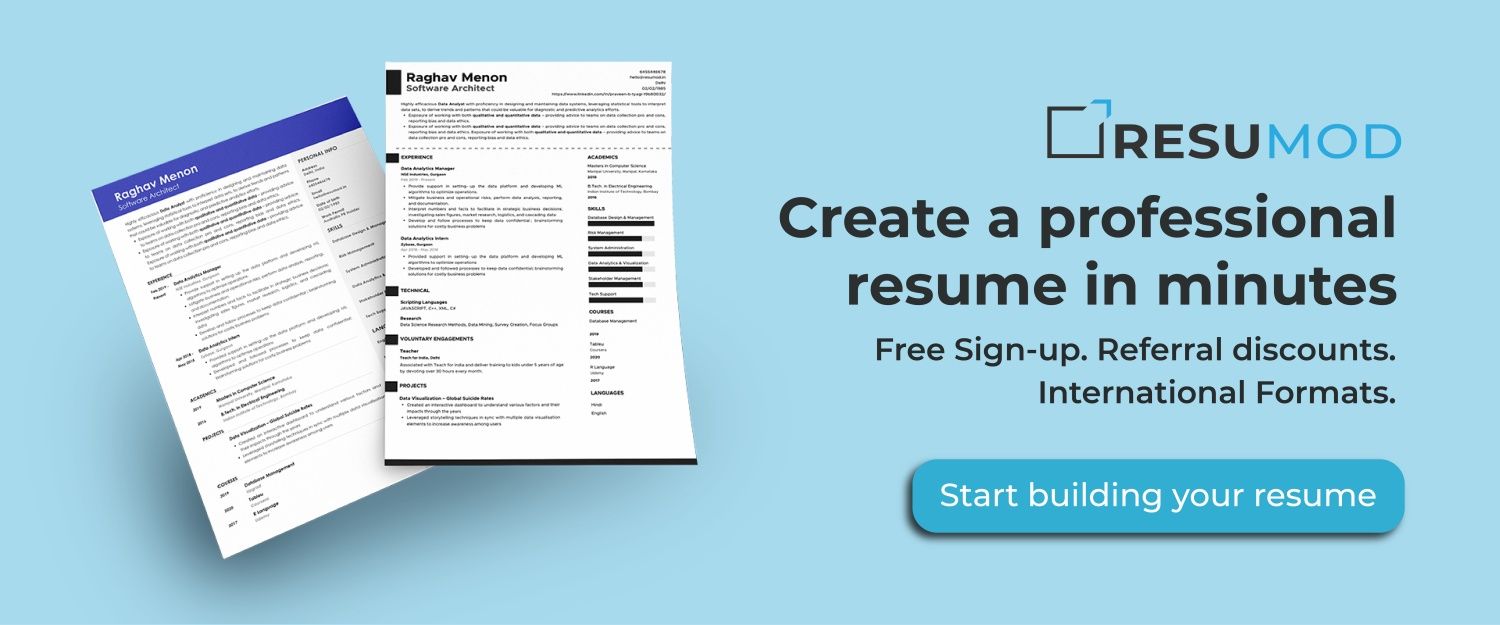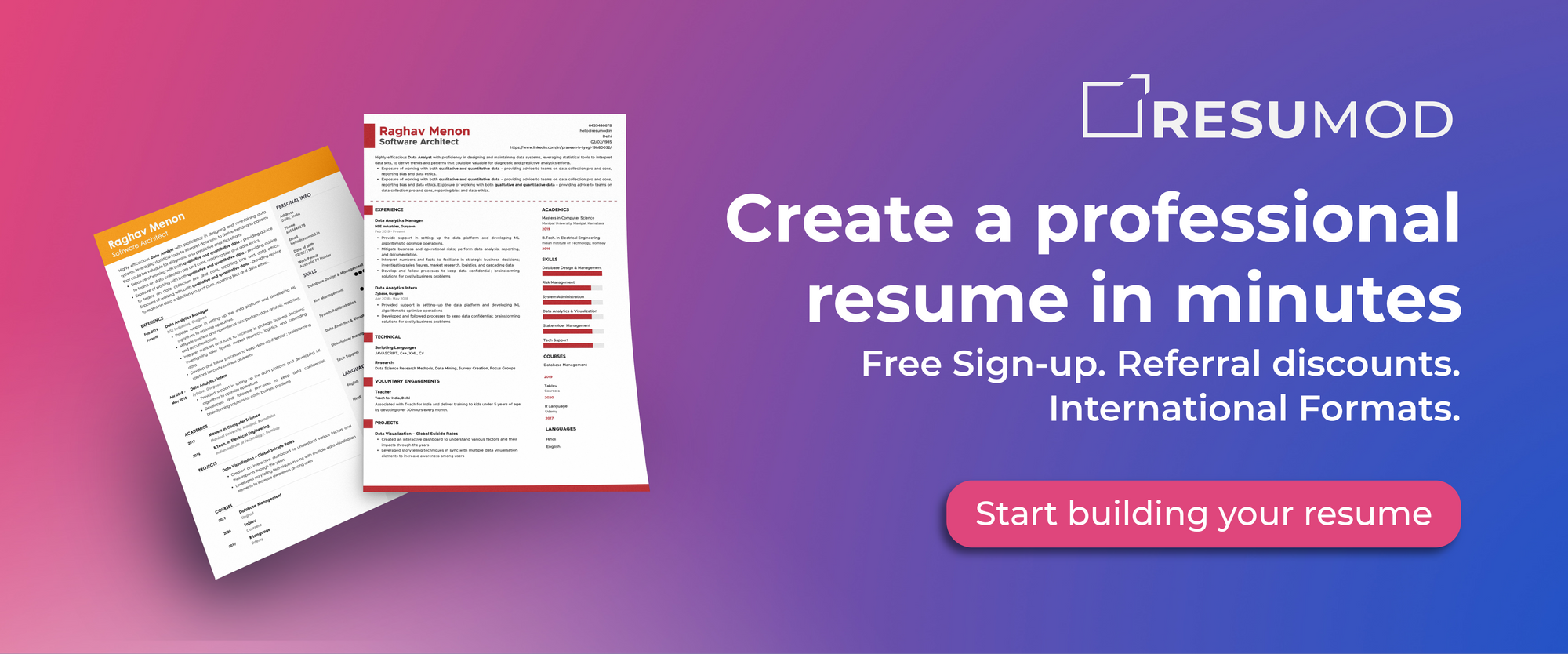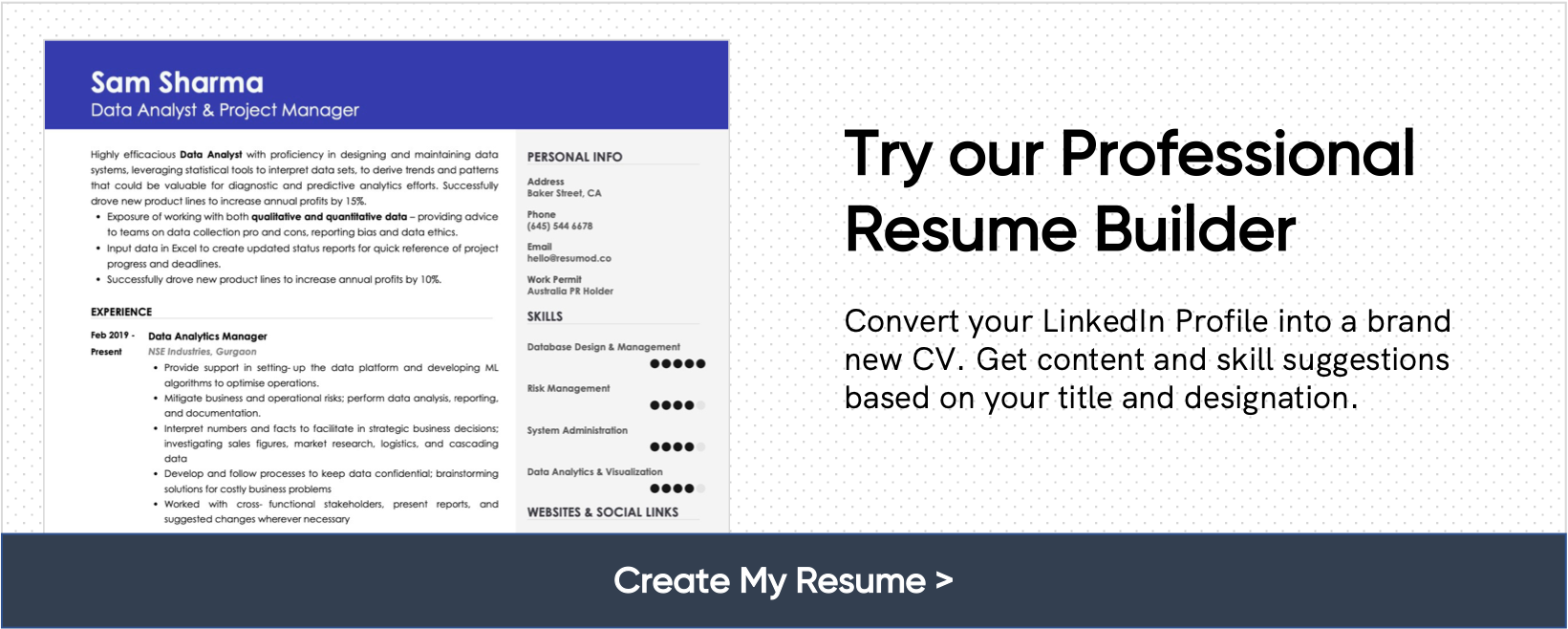How to Write a Doctor's Resume: Step-by-step Guide
While doctors can set a broken bone, diagnose a rare disease, or even operate, but it doesn’t teach them how to write a resume.
While doctors can set a broken bone, diagnose a rare disease, or even operate, they tend to be quite competent professionals but not big self-promoters. Medical school teaches doctors know how to diagnose exotic illnesses, but it doesn’t teach them how to write a resume.
Quite ironic, isn’t it? Well, you don’t need to be a professional writer to craft a job-landing resume. If there’s one thing medical school has taught you to do, it’s certainly following instructions and you’re off to a great start.
With this guide, you’ll learn how to write a good medical doctor's resume. So, let’s get started!
In this blog post:
- Understanding the medical job market
- Requirements to become a doctor
- How to write a doctor resume?
- How to format a doctor resume?
- Medical doctor resume mistakes to avoid
- Top rated doctor resumes on Resumod

Most doctors diagnose and treat illnesses and injuries; so, their knowledge, skills, and day-to-day activities vary depending on their specialty area. A typical daily responsibility for physicians includes:
- Conduct patient exams
- Input medical information into patient charts
- Order diagnostic tests for patients and make referrals to other physicians
- Create treatment plans for patients
- Patient education regarding topics like nutrition and lifestyle changes to enhance health
Work Environment
Doctors usually work in clinical settings like hospitals and physicians’ offices, such as a healthcare organization or a group practice. They also work in non-clinical environments, like nonprofit organizations, government offices, and insurance agencies.
Common Challenges
The knowledge from which you are making a good living while saving lives can be very rewarding. However, the medical field has some potential struggles:
- High levels of stress
- Burnout
- Poor work-life balance
- Healthcare staff shortages
- Too much paperwork and time spent working on electronic health records
- Problems getting properly reimbursed by insurance companies
Understanding the medical job market
Understanding the current landscape of the medical profession in India requires a look at various statistics related to the number of doctors, distribution, specialties, and more. Here are some key statistics about Indian doctors:
Registered Doctors:
- As of 2023, there are over 1.3 million registered doctors in India according to the Medical Council of India (MCI) and the National Medical Commission (NMC).
- Out of these, approximately 80% are actively practicing.
Doctor-to-Patient Ratio:
- The doctor-to-patient ratio in India is approximately 1:1404, which is lower than the World Health Organization (WHO) recommended ratio of 1:1000.
Distribution by Specialization
General Practitioners:
- A significant portion of Indian doctors are general practitioners or family doctors.
Specialists:
The distribution of specialists is as follows:
- Internal Medicine: 13%
- Paediatrics: 11%
- Obstetrics and Gynaecology: 10%
- Surgery: 9%
- Anaesthesiology: 7%
- Orthopaedics: 6%
- Cardiology: 5%
- Dermatology: 4%
- Other Specialties: 35%
Geographic Distribution
Urban vs. Rural:
- Around 75% of doctors practice in urban areas, leaving only 25% in rural areas where nearly 70% of the population resides.
- This urban-rural divide highlights a significant healthcare accessibility issue in rural India.
State-wise Distribution:
- States with the highest number of doctors include Maharashtra, Tamil Nadu, Karnataka, Andhra Pradesh, and Uttar Pradesh.
- Northeastern states and some central and northern states have a lower density of doctors.
Gender Distribution
- The medical profession in India has traditionally been male-dominated, but the number of female doctors is increasing.
- Approximately 42% of doctors are women, with higher percentages in fields like paediatrics and obstetrics, and gynaecology.
In India, the average starting salary for doctors with an MBBS degree and 4-5 years of experience is around INR 5.04 LPA. However, senior doctors can earn up to INR 12.5 L to 18.4 LPA. Those with higher degrees (such as MS or MD) can make up to INR 10 LPA after 5-7 years of experience. Surgeons, gynaecologists, and prosthodontists are among the highest-paid doctors, with average annual salaries of INR 1.91 Crore, INR 1.77 Crore, and INR 1.67 Crore, respectively. Government hospital doctors earn around INR 38 LPA, while private hospital doctors earn around INR 50.4 LPA12. Approximately 75% of doctors in India earn less than USD 860, with half earning less than USD 6003.
Requirements to Become a Doctor?
Becoming a doctor in India involves a rigorous process of education and training. Here's a step-by-step guide to help you navigate this journey:
Step 1: Complete Higher Secondary Education (10+2)
- Choose the Science Stream: Enroll in the science stream with Physics, Chemistry, and Biology (PCB) as core subjects.
- Achieve High Marks: Aim for excellent marks in your 12th standard exams, particularly in PCB subjects, to be eligible for medical entrance exams.
Step 2: Clear Medical Entrance Exams
- National Eligibility cum Entrance Test (NEET): NEET is the primary entrance exam for MBBS and BDS courses in India. Prepare thoroughly with coaching classes, study materials, and practice tests.
- Additional Entrance Exams: Some states and private institutions may have their entrance exams, though most have moved to NEET.
Step 3: Apply to Medical Colleges
- Research Medical Colleges: Consider factors such as college reputation, faculty, infrastructure, and placement records. Government colleges generally have lower fees compared to private institutions.
- Submit Applications: Apply to colleges based on your NEET score and state rank. Participate in the counselling process to secure a seat in a medical college.
Step 4: Complete MBBS Degree
- Enrol in an MBBS Program: The MBBS course duration is typically 5.5 years, including a one-year mandatory rotating internship.
- Attend Classes and Practical Sessions: Study subjects such as Anatomy, Physiology, Biochemistry, Pharmacology, Pathology, Microbiology, and Community Medicine. Gain practical experience through clinical rotations and lab work.
- Internship: Complete a one-year rotating internship in various departments like Medicine, Surgery, Paediatrics, Obstetrics and Gynaecology, etc.
Step 5: Register with the Medical Council
- Obtain Provisional Registration: Apply for provisional registration with the State Medical Council after completing the MBBS course and internship.
- Get Permanent Registration: After passing the final exams and completing the internship, apply for permanent registration to practice as a doctor.
Step 6: Pursue Postgraduate Studies (Optional but Recommended)
- PG Entrance Exams: For specialization, clear entrance exams such as NEET-PG, AIIMS PG, JIPMER PG, or other state-level PG exams.
- Enrol in a Postgraduate Program: Pursue an MD/MS degree in your chosen specialty. The duration is typically 3 years. Alternatively, you can opt for a diploma course (2 years) in a specialized field.
Step 7: Super Specialty Training (Optional)
- Entrance Exams for Super Specialty Courses: After post-graduation, you can take entrance exams like NEET-SS for super-specialty courses (DM/MCh).
- Complete Super Specialty Training: Enrol in a super specialty course (DM/MCh), which usually lasts 3 years.
Step 8: Start Practicing as a Doctor
- Work in Hospitals or Clinics: Start your practice in hospitals, clinics, or private practice. Gain experience in treating patients and managing medical cases.
- Continuing Medical Education: Stay updated with the latest advancements in medicine by attending workshops, and conferences, and pursuing additional certifications.
Additional Considerations
- Rural Service Bond: Be aware that some states may require you to complete a mandatory rural service bond as part of your medical education agreement.
- Licensing Exams for Abroad Practice: If you wish to practice medicine abroad, you may need to clear licensing exams such as USMLE (USA), PLAB (UK), AMC (Australia), etc.
How to Write a Doctor’s Resume
Here are some useful steps you can follow to help you create a professional doctor resume:
Structure your doctor's resume
When deciding on the structure of your resume, it's important to choose a professional format. This can foster a positive first impression and improve the readability of your resume. Here are some structural recommendations to consider:
- Use simple resume fonts such as Times New Roman or Arial.
- Select a 10- or 12-point size font for the majority of your resume's content, with the main heading in two font sizes bigger and other headings bold to easily distinguish sections.
- Include some white space around subheadings to further enhance readability.
- Consider using an existing resume template to ease creating your resume.
- Save your resume in a PDF format to enhance its professional appearance but consider creating a format that employers specify.
Create an eye-catching header section
The header section is the most important section of your resume. This section typically contains your name in bold and your contact details. Always begin this section with your name. You can consider including your academic titles, such as Dr., before your name and other qualifications, such as MD, after your name after a comma. Next, include a professional email address, but avoid using your current work email address. You can also include the city and state where you live, but this is optional. Then, include a link to your professional website if you have one.
Write an informative professional summary
A professional summary provides employers with insight into your medical experiences and allows you to describe your top medical achievements. This also allows you to introduce the rest of your resume with your top medical skills and competencies, which can help employers understand why you're the ideal fit for a doctor or physician role. Keeping this section between two to three sentences can ensure you only include your number of years of experience working as a doctor and your most notable accomplishments and skills that relate to the available doctor position.
Begin each sentence in this section with a strong adjective or verb, and also demonstrate what you hope to achieve in the position. Remember to use keywords from the job description and key soft skills you possess that are necessary for this role. Also, consider quantifying your experiences or accomplishments if possible.
Example: Experienced doctor with over 10 years of experience in providing high-quality medical care to over 1000 patients. Skilled in providing efficient and detailed analysis of patients to enhance individual health and well-being while collaborating with patient care teams to ensure the continuance of quality care. The dedication to enhancing patient care capabilities resulted in the creation of a new patient care routine that produced a 25% increase in patient satisfaction and helped improve employee satisfaction by 14%.

Add your work experience
When adding your previous work experience as a doctor or in the medical field, it's important to list your experience in reverse chronological order. This enables you to highlight your most recent position first and can help you show how that role relates to the new doctor position for which you're applying, as recruiters often only read this section when shortlisting a candidate for a medical doctor position. Beginning your experiences with action words, such as “facilitate” or “collaborate,” can help you integrate your skills into your experience.
Following these action verbs with your duties can help employers understand your proficiency and envision how you might perform in a doctor role with their facility. Whenever possible, quantify your accomplishments. List up to five statements when describing your most recent experience and up to three for older positions. Here are some examples:
- Provide personalized services to ensure patient satisfaction, which helped increase patient satisfaction by 11% in two quarters.
- Facilitate a reduction in cost by 18% for staffing and supplies by creating new schedule tracking procedures.
- Maintain 87% success rates that surveys and annual follow-up calls for patient goal attainment measured.
- Collaborated with 30 nursing and administrative team members to expedite record-keeping practices, which reduced labour hour requirements by six hours each week.
List your education
It's a good idea to add only your highest and most relevant education to this section to emphasize that credential over other degree programs you might have completed. If you have any relevant certifications, you can add this information below your education to further distinguish yourself from other doctor candidates. Avoid writing lengthy paragraphs in this section and only include the type of degree, your major and minor, starting and graduating years, and the university and location.
Add skills that are relevant to the position
In this section, essential skills that hospital administrators or recruiters may require. To help you determine which skills to incorporate into your resume, consider making a list of all the skills the potential employer requires. Then, you can make a list of your soft and technical skills to compare. Ensure to keep your skills section between six and 10 skills to emphasize your top talents and to keep your resume concise. Some skills you might consider incorporating include:
- Leadership
- Communication
- Time management
- Teamwork
- Stress management
Some hard skills you might use include:
- Pharmaceutical
- Oncology
- Critical care
- Anaesthesia
- Family medicine
- Budgeting
Add any other relevant activity
This section can help expand on why you're the ideal fit for a doctor position, as it can help distinguish your capabilities from other doctors with similar educational or professional experiences. Include any awards, licenses and certifications, volunteer work, second languages, publications, and membership in relevant professional organizations. This section is also helpful if you're a new doctor, as it can further demonstrate the technical abilities you've acquired outside of professional work experience.
How to Format a Doctor Resume
The format is the first thing recruiters notice when they look at a resume. Make a good impression and demonstrate your organizational skills with a doctor’s resume that’s clear and easy to read.
Doctors work in clinical environments where every detail matters. Show recruiters that you can communicate information efficiently and effectively with every section of your resume.
Consider these key elements for a doctor's resume format that catches recruiters' attention:
- Reverse chronological layout: As the name suggests, a reverse chronological layout focuses on your work experience in reverse chronological order. Show that you are committed to your role and have gained clinical experience over time with a strong work history.
- Professional header: Include a header at the top of your resume that clearly states your title and professional contact information. Make a good introduction by including a certification or specialization associated with your role.
- Single page: Doctors need to meet specific requirements, particularly in specialized fields. Save hiring managers time by limiting your doctor's resume to your relevant skills and experience.
- ATS optimized: Select fonts and file formats that are optimized for Applicant Tracking Systems. Use resume builders like Resumod to accomplish all the above and give your doctor’s resume the best chance of making it to a human recruiter.
The Top Sections on a Doctor Resume:
- Personal information: This section includes the contact information; it's essential as it helps recruiters to reach out.
- Career objective: An outlined career goal demonstrates commitment and personal direction aligned with the role.
- Medical licenses and certifications: Proof of eligibility to practice and additional qualifications unique to the medical field.
- Clinical experience and residencies: This showcases practical experience and past responsibilities in healthcare settings.
- Medical education and training: Highlights the scope of knowledge and specialization unique to the medical profession.
What Recruiters Want to See on Your Resume:
- Board certification: It asserts that the candidate meets nationally recognized standards for education, knowledge, and skills in medicine, ensuring quality patient care.
- Clinical experience: Practical experience in medical settings is valued as it confirms the candidate's ability to apply their knowledge successfully.
- Specialization: Doctors with a specific area of expertise are often preferred as they bring in-depth knowledge and skills to the role.
- Publications and research: Involvement in research and having published works demonstrate intellectual curiosity and contribution to the medical field.
- Recommendations or references: They provide insights into the candidate's professional conduct and reputation within the healthcare community.
Medical Doctor Resume Mistakes to Avoid
Crafting a medical doctor's resume requires attention to detail and precision. To increase your chances of getting hired, it's crucial to avoid common mistakes that can undermine your qualifications.
Common Medical Doctor Resume Mistakes
When creating a resume, applicants often make several common errors. Familiarizing yourself with these mistakes can help you avoid them:
- Failing to highlight relevant qualifications and experience
- Using inappropriate language or poor grammar
- Including irrelevant or outdated information
- Failing to tailor the resume to the specific job posting
- Failing to showcase achievements and accomplishments
- Neglecting to include contact information or using incorrect contact information
How to Avoid Medical Doctor Resume Mistakes
To create a winning resume and steer clear of common mistakes, consider the following tips and strategies:
- Highlight your qualifications and experience: Ensure you include all relevant qualifications and experience, including any areas of specialization or certifications. Use bullet points to list your skills and experience for better readability.
- Use appropriate language and grammar: Proofread your resume carefully to eliminate spelling and grammar errors. Maintain a professional tone and avoid slang or informal language.
- Tailor your resume to the specific job posting: Carefully review the job posting to identify the key skills and qualifications required. Use these as a guide to emphasize your relevant strengths and experiences.
- Showcase your accomplishments and achievements: Instead of merely listing duties and responsibilities, provide concrete examples of your accomplishments and achievements in previous positions. This demonstrates your value and potential for future success.
- Include accurate contact information: Double-check that all contact information is accurate and up-to-date, including your email address, phone number, and professional social media profiles.
By following these tips and avoiding common resume mistakes, you can create a strong and effective medical doctor resume that will help you stand out to potential employers.
Top Rated Doctor Resumes on Resumod
Resume of Junior Doctor
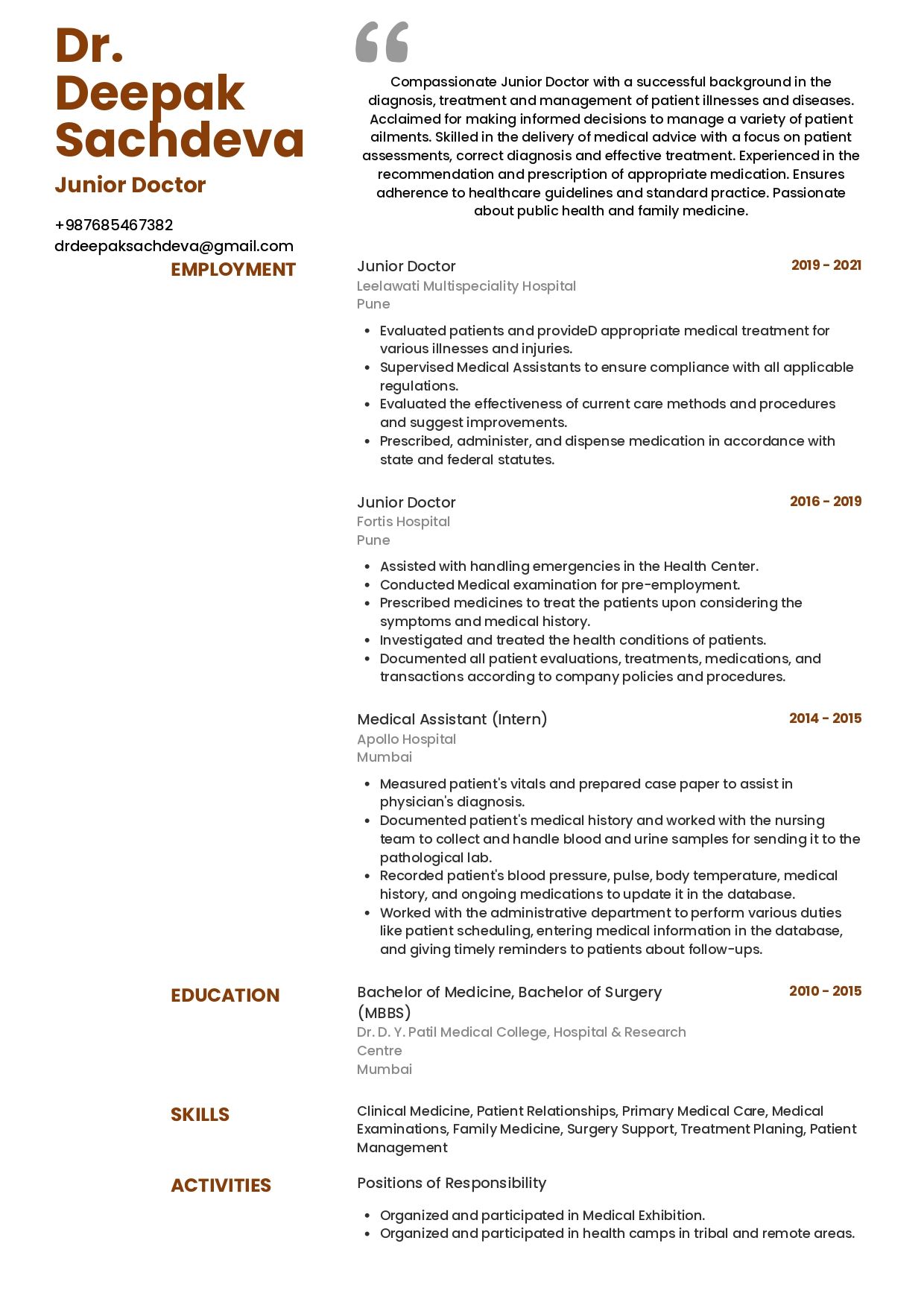
Check the full resume of junior doctor in text format here.
Resume of Homeopathic Doctor
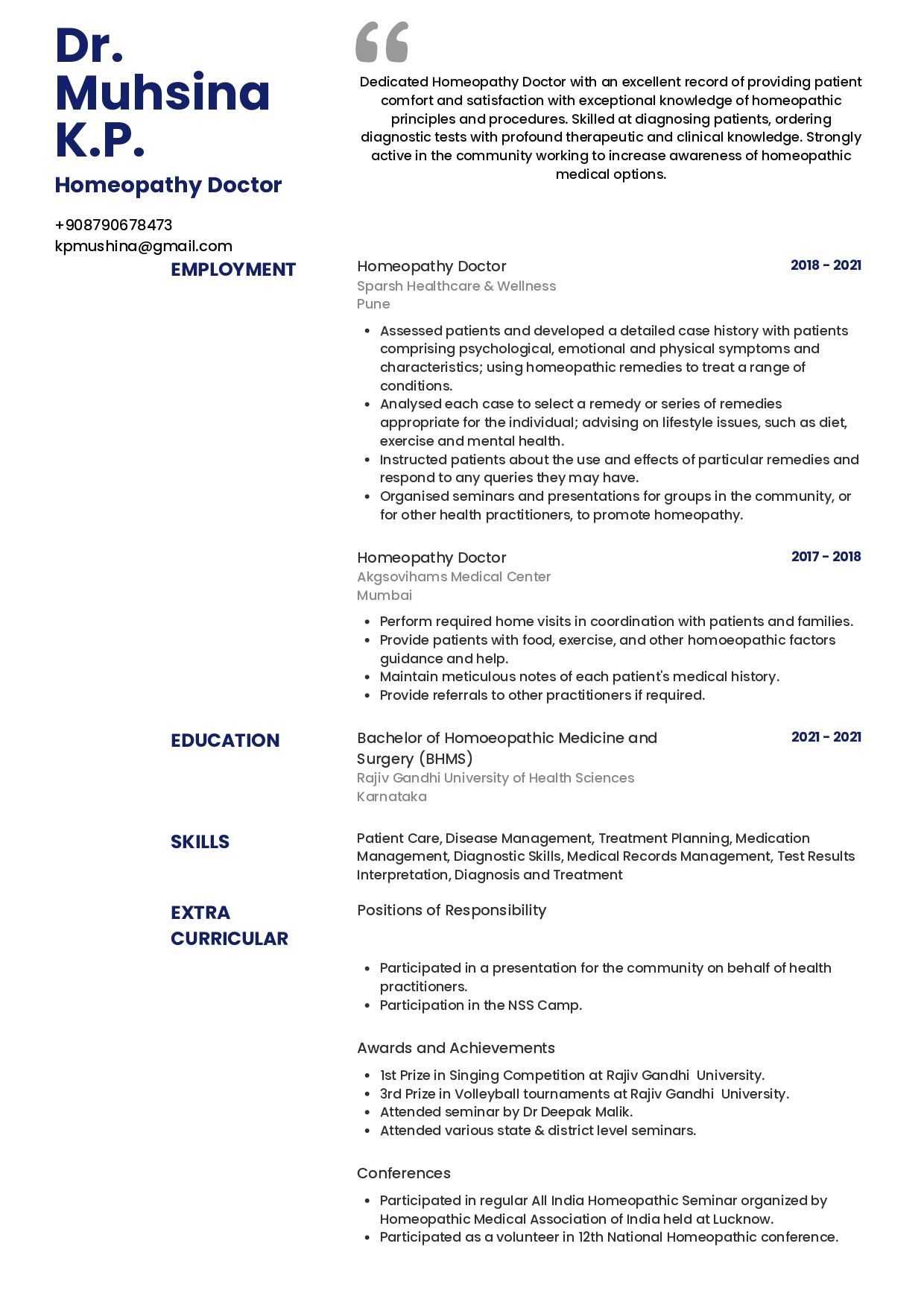
Check the full resume of homeopathic doctor in text format here.
Resume of ENT Specialist

Check the full resume of ENT Specialist in text format here.
Resume of Dermatologist

Check the full resume of Dermatologist in text format here.
Resume of Oral and Maxillofacial Surgeon
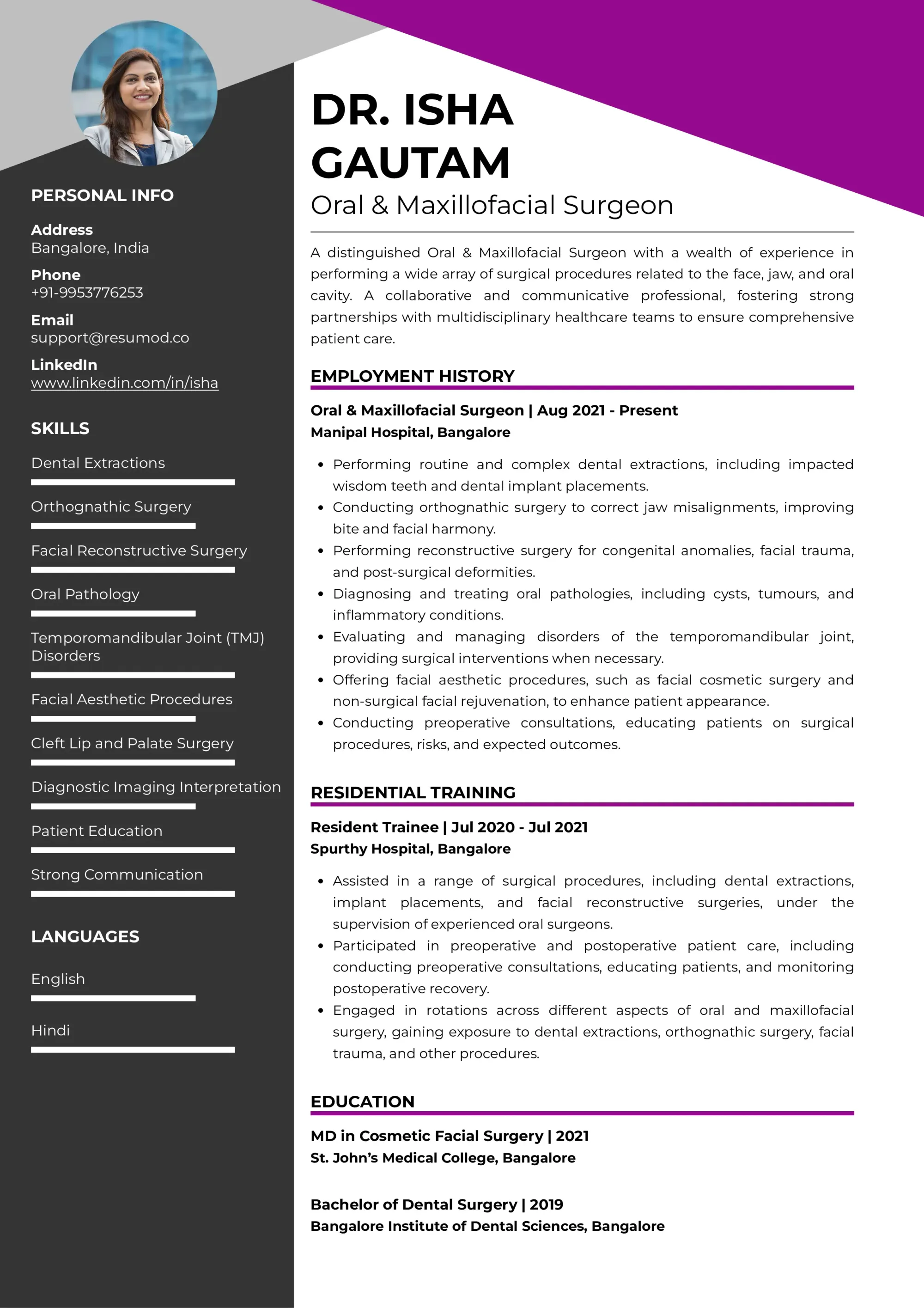
Check the full resume of oral and maxillofacial surgeon in text format here.
Resume of Anesthesiologist
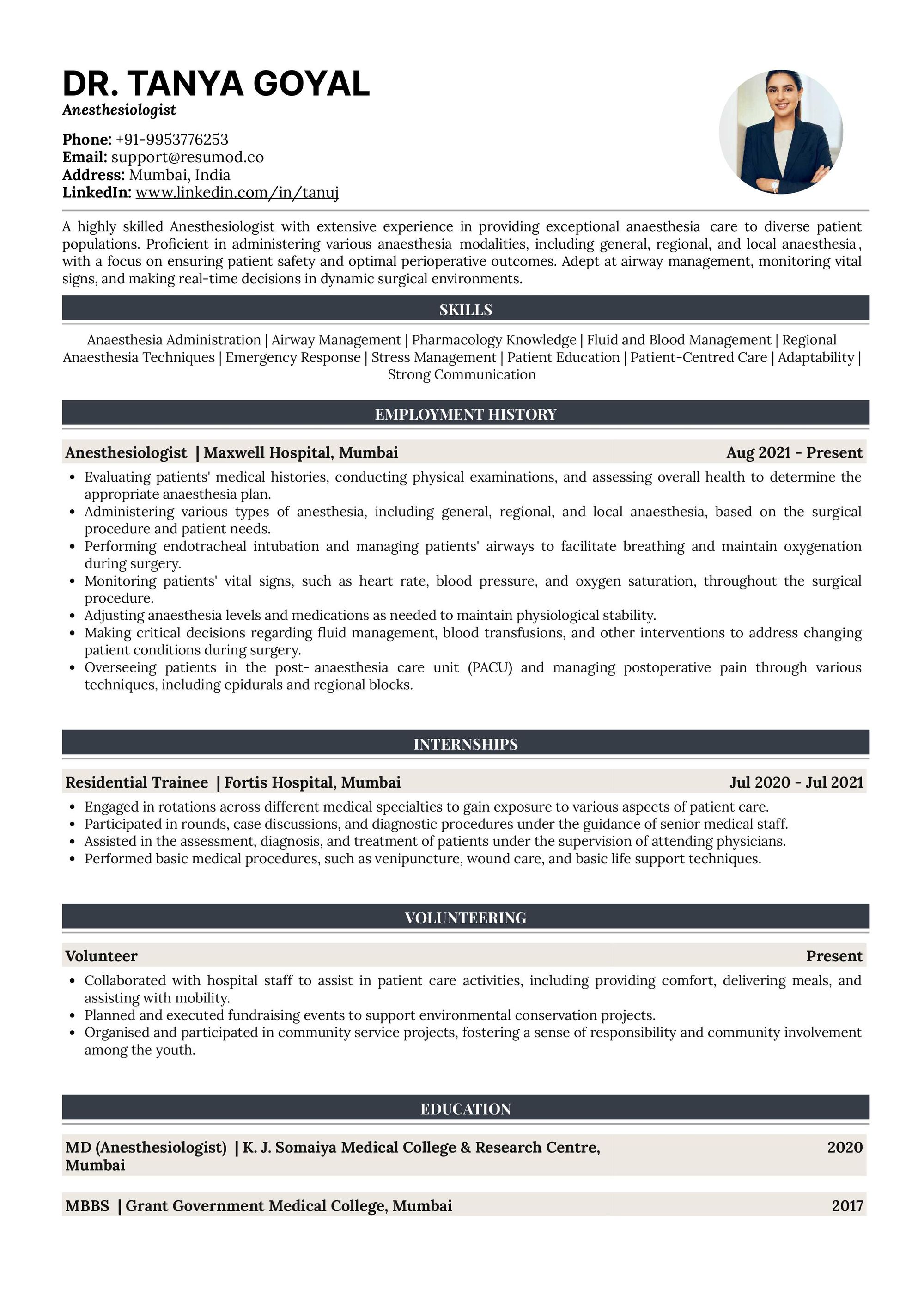
Check the full resume of anesthesiologist in text format here.
Resume of Neurosurgeon
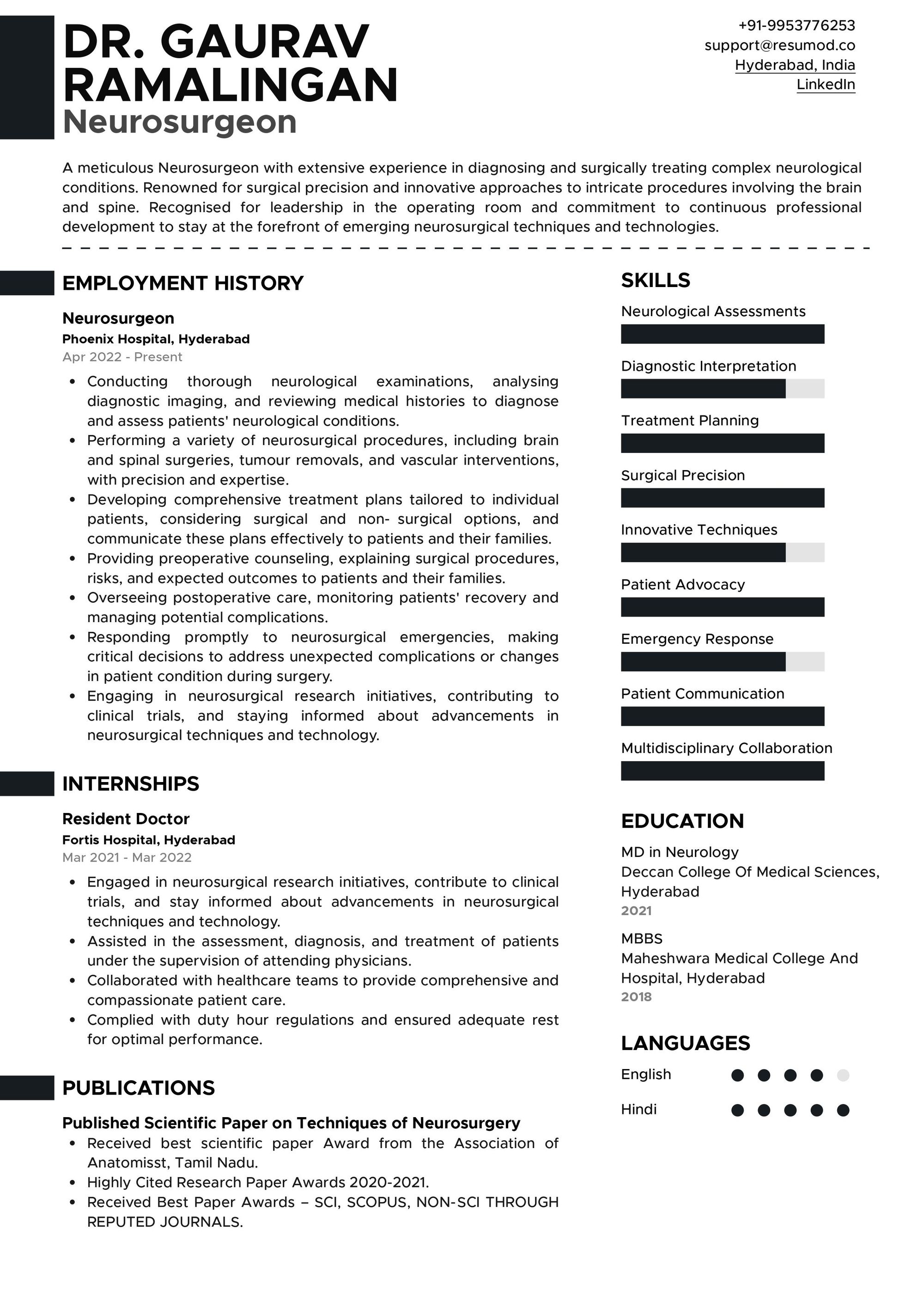
Check the full resume of neurosurgeon in text format here.
Resume of Internal Medicine Specialist
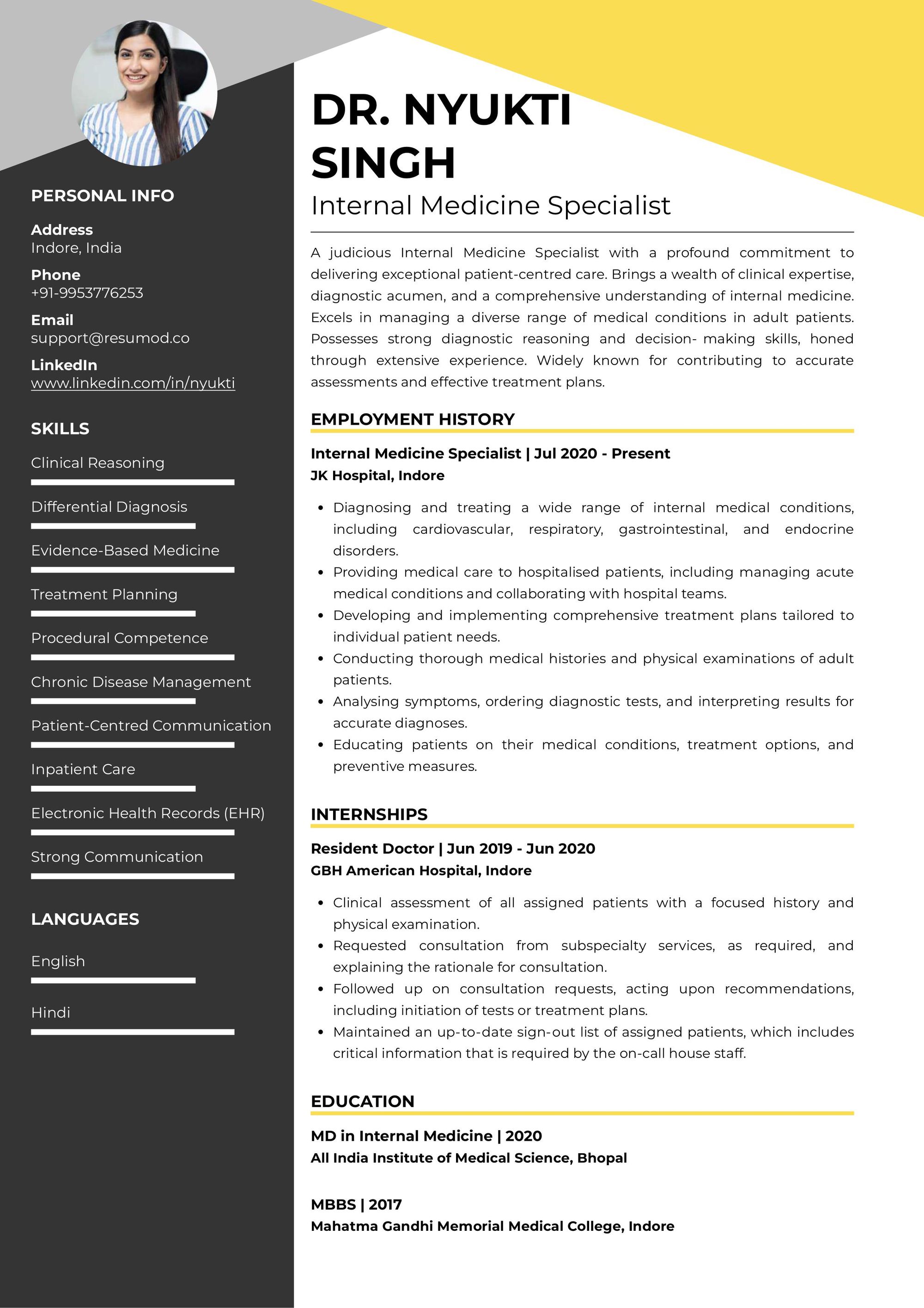
Check the full resume of internal medicine specialist in text format here.
Resume of Gynecologist
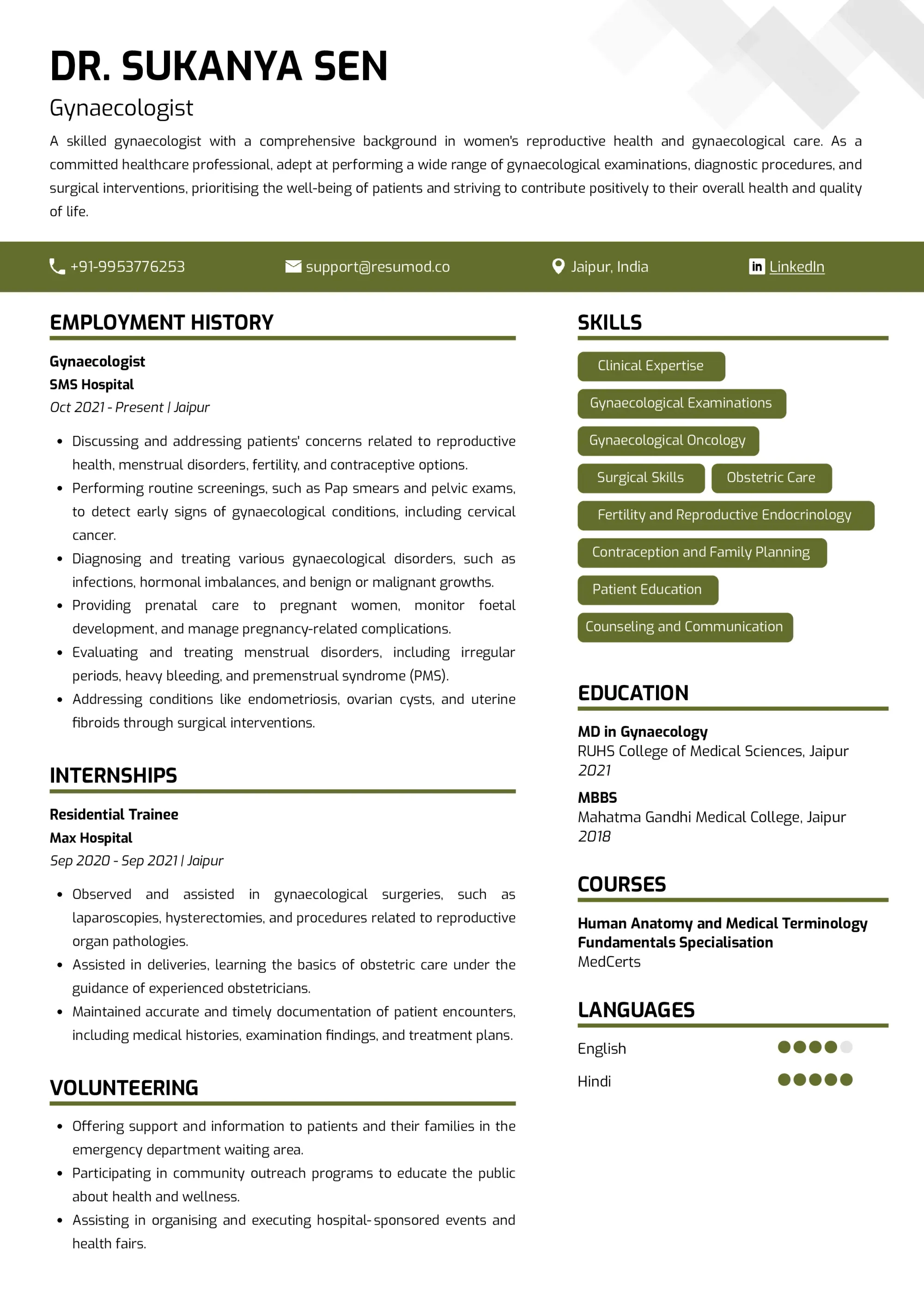
Check the full resume of gynecologist in text format here.
Resume of Physician
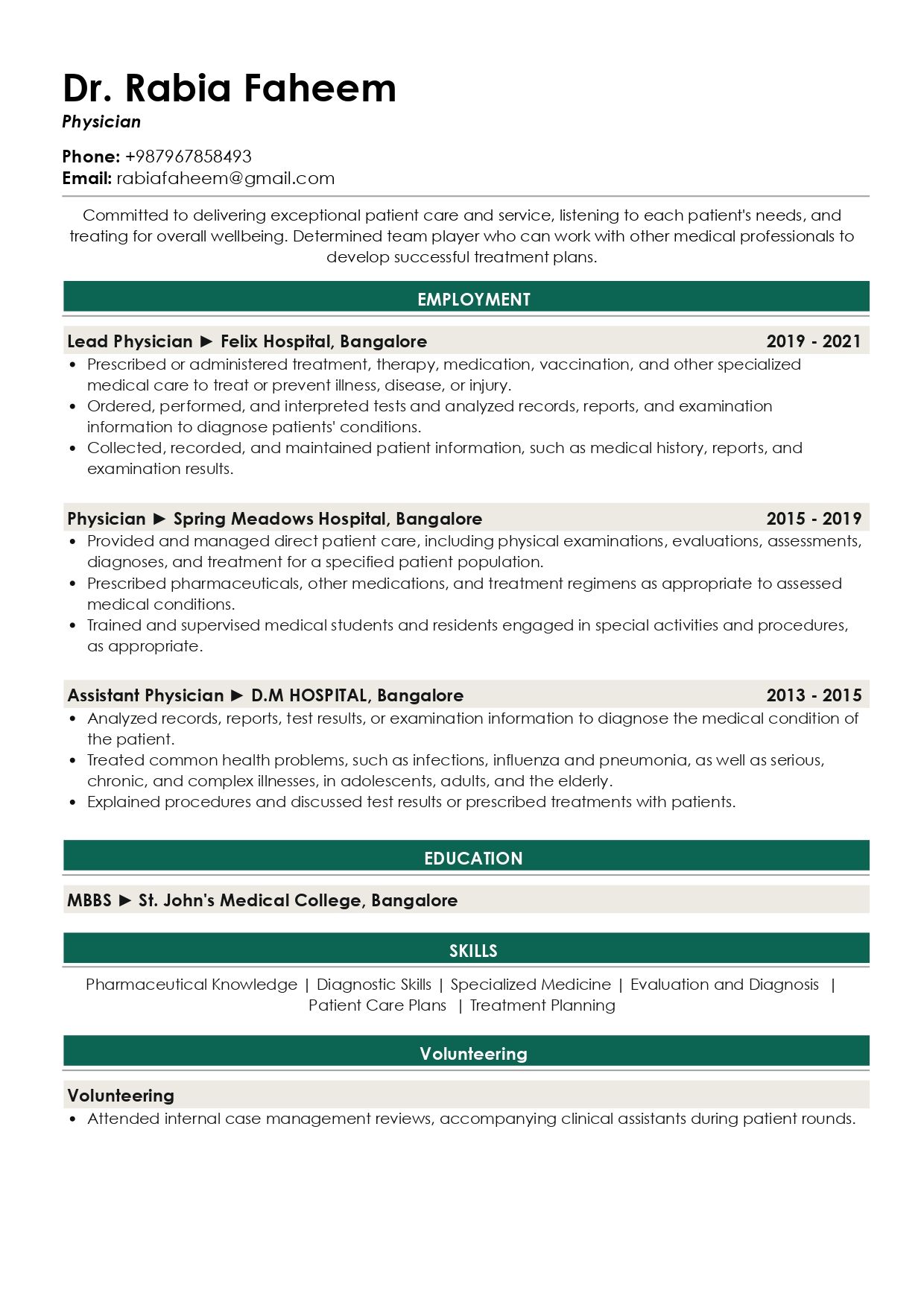
Check the full resume of physician in text format here.

